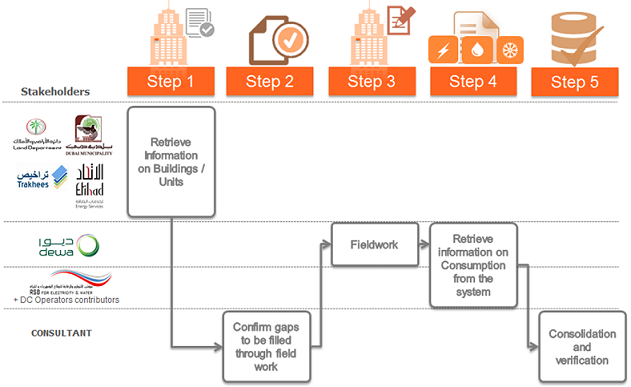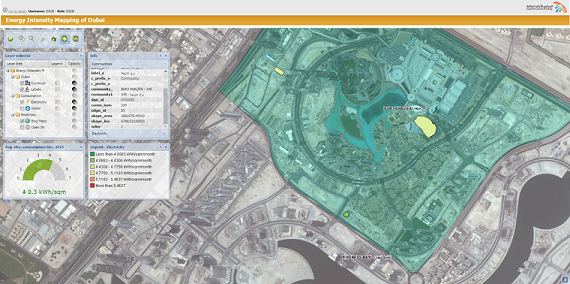Integrated Energy Intensity Mapping of Dubai (IEIM)
Applus+ has successfully developed and completed the pilot implementation phase of the Integrated Energy Intensity Mapping of Dubai.
This project has been developed for the Dubai Supreme Council of Energy according to the vision of the Dubai Integrated Energy Strategy (DIES) 2030 that foresees Dubai to become a role model in energy efficiency.
The mission of the Dubai Supreme Council of Energy is to support Dubai’s economic growth through the secure supply and efficient use of energy, while continuing to meet its environmental and sustainability objectives.
The Dubai Demand Side Management (DSM) strategy 2030 foresees the ongoing development of capabilities in the field of energy- and water-intensity mapping from the early years of implementation.
Such capabilities will allow the Dubai government to assess patterns of consumption on a continuous basis, with a view to monitoring the success of the DSM measures that have already been implemented as well as identifying opportunities for future action.
PROJECT PURPOSE AND DESCRIPTION
The main requirement of the project was to develop a pilot monitoring system for energy & water intensity for a relevant sample of buildings in Dubai.
The project’s ultimate aim was to gain insight into and define the roadmap for a full-scale implementation of the energy intensity mapping system across all buildings in Dubai. The project has been developed in four phases.
Phase 1: Preliminary design
The main goal of the first phase was to define the preliminary design of the database.
To this end, our team held a series of meetings with all the stakeholders involved in the project. During these meetings, our team has to understand the database structures as well as of how best to obtain the requested project data from the different stakeholders’ databases. We also defined the necessary database-linking procedures.
The building sample for the pilot was also defined during this phase.
The particular sample of buildings was selected with a view to gaining insight for the full-scale implementation project (for example, regarding data quality and gaps). To achieve this goal, the following two criteria were used:
- The need to involve different information sources (stakeholders) and different types of consumers.
- The desire to include a range of different communities in Dubai and to achieve a sample distribution based on the representative consumption of different types of buildings.
Phase 2: Data collection
The main goal of this second phase was to collect all the data requested from the different stakeholders for the project system.
To achieve this goal, Applus+ prepared and developed a specific Data Request Process (D.R.P.). We ran a workshop for all stakeholders to explain the methodology and the detailed information that was required for the project.
Phase 3: Pilot prototype
The main goal of phase 3 was to to complete the development of Pilot prototype. This phase was successfully carried out in two stages: the first with dummy data and the second with real data collected from the D.R.P.
The Energy Intensity Map enables data analysis for policy-making and supports the monitoring of the Demand Side Management Strategy and its nine programs of Dubai government.
The Energy Intensity Map is a unique database that combines consumption (kWh and imperial gallons for water) and building (sqm, usage, type of building, sector) information from different authorities. In addition, the tool provides an easy visualization of energy intensity in buildings through a virtual and interactive map with a user-friendly website interface.
The tool is also equipped with the necessary functionalities to download reports for analytical purposes at unit, building, community and city levels.
In addition, the tool enables a comparison of energy or water consumption over time versus a baseline scenario for any given building, community or sector, which facilitates the tracking of consumption savings. Furthermore, the tool can monitor the impact of existing Demand Side Management programmes such as the number of buildings that are compliant with the Dubai Green Building Regulation or the number of buildings that have been retrofitted with a particular technology (and the resultant savings achieved).
A total of 47 energy and water indicators have been identified as potentially to be measured by the tool.
The map can also be used for modelling and simulations. For instance, the tool can produce consumption scenarios for new electricity and water tariffs. It can also monitor greenhouse gas emissions and, with the use of smart meters, this information can be instantly gathered and analyzed.
Phase 4: Full-scale implementation roadmap
The objective of this final phase of the project was to develop a roadmap based on all the knowledge accrued during the development of the pilot prototype.
This document establishes a clear path to scale-up the pilot version of the Integrated Energy Intensity Map (IEIM) to be rolled out across all buildings in Dubai. The roadmap defines the series of projects required to achieve this goal and their respective timelines.
The successful scale-up of this project requires resolving a number of data gaps with stakeholders, upgrading the system’s capacity both in terms of hardware and software, and adding certain new functionalities.
In summary, the main objectives of this project were successfully achieved: 1) implementation of the pilot prototype and 2) definition of a roadmap for the system’s full-scale implementation across all buildings in Dubai.
The roadmap is currently being studied by the government of Dubai with a view to being rolled out in the near future.




